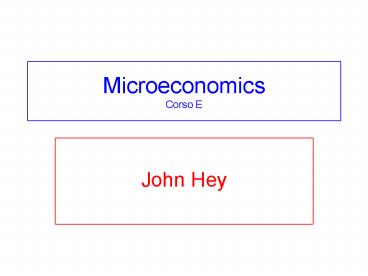Microeconomics Corso E - PowerPoint PPT Presentation
1 / 14
Title:
Microeconomics Corso E
Description:
Here 3 is the endowment of the good and 30 that of money, p is the price of the good, q the quantity consumed and m the amount of money left to spend on other goods. ... – PowerPoint PPT presentation
Number of Views:56
Avg rating:3.0/5.0
Title: Microeconomics Corso E
1
MicroeconomicsCorso E
- John Hey
2
What do we know?
- The reservation price of a buyer is...
- ...the maximum price he or she would pay.
- The reservation price of a seller is ...
- ...the minimum price he or she would accept.
3
What do we know?
- The surplus of a buyer is ...
- ... the area between the price paid and the
demand curve. - The surplus of a seller is ...
- ... the area between the price received and the
supply curve. - An indifference curve is ...
- ... a set of points about which the individual is
indifferent.
4
An indifference curve and reservation prices
- Beginning at the point (0,9)
- Buyer
- For the first unit 4
- For the second 3
- For the third 2
5
Reservation prices and the demand curve
- Beginning at the point (0,9)
- Buyer
- For the first unit 4
- For the second 3
- For the third 2
6
An indifference curve and reservation prices
- Starting at the point (3,0)
- Seller
- For the first unit 2
- For the second 3
- For the third 4
7
Reservation prices and the supply curve
- Starting at the point (3,3)
- Seller
- For the first unit 2
- For the second 3
- For the third 4
8
Deduction and inference
- If we know the preferences of the individual (the
indifference curves or the reservation prices)
and the endowment of the individual... - ...we can deduce the demand curve or the supply
curve of the individual... - If instead we observe the demand and supply of
the individual... - ...we can infer the preferences of the individual.
9
Deduction and inference
- The preferences of the individual (the
indifference curves or the reservationprices) and
the endowment - ? ?
- Whether the individual is a buyer or a seller and
either the demand or supply curve of the
individual.
10
A Quiz
- I do not like Japanese beer...
- ...hence I never buy Japanese beer.
- Hence my indifference curves (between money and
Japanese beer) are ...? - .....
- My reservation prices (as a buyer) for Japanese
beer are ....?
11
Chapter 4
- In Chapter 3 we have worked with a discrete good
that is, a good that can be traded in integer
units. - In Chapter 4 we work with a perfectly divisible
good .... which can be traded in any quantities,
not only integer units. - We continue to work with a particular kind of
preferences quasi-linear ... - ... which imply indifference curves parallel in a
vertical direction.
12
If you like mathematics...
- m 60/q costant is the equation of an
indifference curve the larger the constant, the
higher the indifference curve. - pq m 3p 30 is the equation of the budget
line. Here 3 is the endowment of the good and 30
that of money, p is the price of the good, q the
quantity consumed and m the amount of money left
to spend on other goods. - If we maximise the constant given the budget
constraint we obtain the gross demand for the
good - q v(60/p)
- The individual begins with 3 units of the good
hence the net demand is - q v(60/p) 3
- Note this is positive if p lt 60/9 6.66666...
- is negative if p gt 60/9 6.6666...
- is zero if p 60/9 6.6666....
13
Chapter 4
- Goodbye!
14
(No Transcript)































